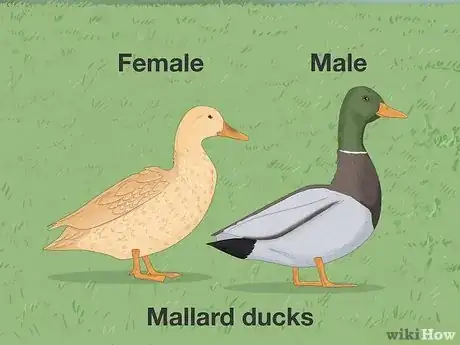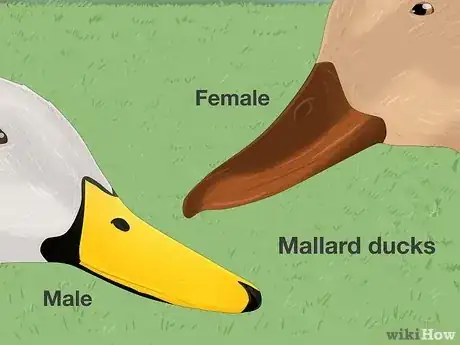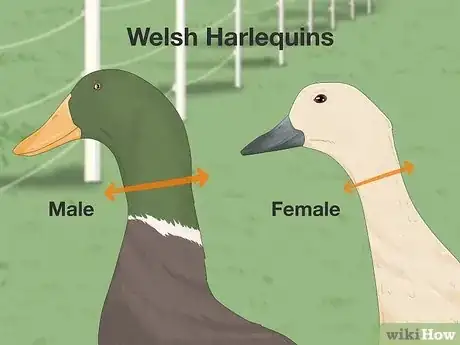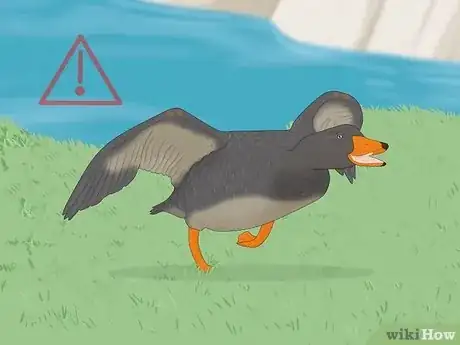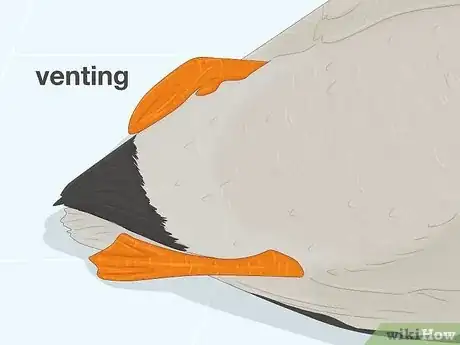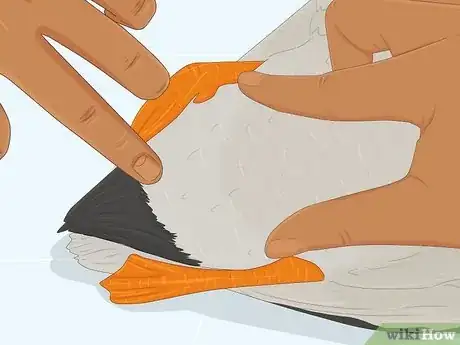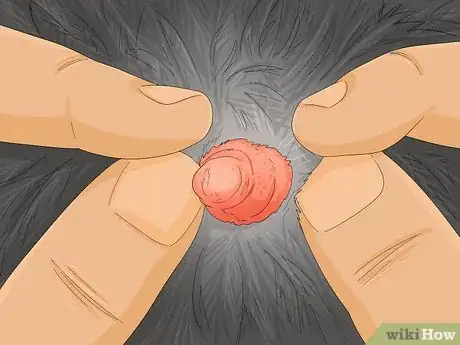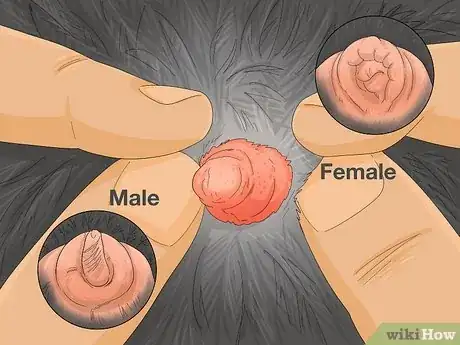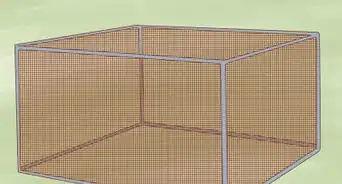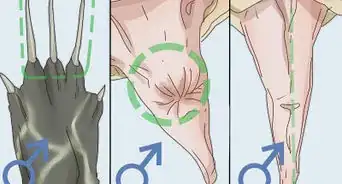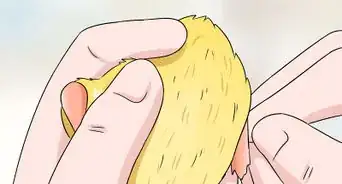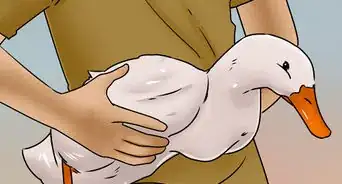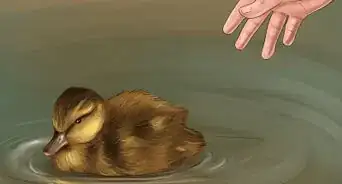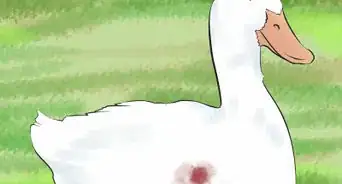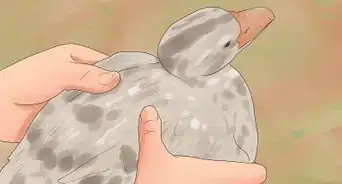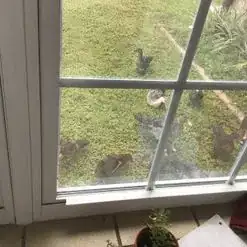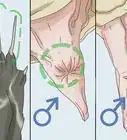This article was co-authored by Pippa Elliott, MRCVS and by wikiHow staff writer, Luke Smith, MFA. Dr. Elliott, BVMS, MRCVS is a veterinarian with over 30 years of experience in veterinary surgery and companion animal practice. She graduated from the University of Glasgow in 1987 with a degree in veterinary medicine and surgery. She has worked at the same animal clinic in her hometown for over 20 years.
There are 15 references cited in this article, which can be found at the bottom of the page.
wikiHow marks an article as reader-approved once it receives enough positive feedback. This article has 16 testimonials from our readers, earning it our reader-approved status.
This article has been viewed 855,058 times.
Whether you’re spying them through binoculars or pairing them up to brood, sorting the males ducks (or “drakes”) from the females (often called “hens”) takes a little training. While every duck species has its own unique characteristics and traits, there are a few handy tricks that’ll give away most any drake. We’ll fill you in on how to distinguish male and female ducks based on their appearance, behavior, and sexual organs.
Things You Should Know
- Distinguish between a male and female duck by checking the color of their feathers—male ducks are generally more colorful.
- Take a close look at the duck’s bill and tail feathers. Female ducks often have speckled bills, and male ducks often have a curled tail feather.
- Listen for a female duck's hard, loud quack and compare it to the male's much softer quack.
- Examine a domestic duck’s cloaca (reproductive organ). Male ducks have a protruding penis, while female ducks have an oviduct opening.
Steps
Appearance and Behavior
-
1Observe the color of the duck's feathers. During the mating season (March-July), male ducks generally have very bright coloration in their plumage to attract mates. After mating season, however, the male duck molts, sometimes losing his bright coloration in the process to more closely resemble a female.[1]
- Mallard ducks are sexually dimorphic, which means the males and females look different from each other. The females are brown and relatively dowdy, whereas the males have a vivid purple sash on the wings and are iridescent colors.
- The male Canvasback has solid white to light gray plumage. His female counterpart has plumage that is grayish-brown.[2]
- The male Wood Duck has gray feathers with blue markings on the wings during mating season. The female's plumage is usually grayish-brown.[3]
- Male and female Mottled Ducks have similarly colored feathers, making it difficult to tell them apart by plumage alone.[4]
-
2Observe the color of the duck’s bill. Bill color is another fairly reliable way to tell the difference between male and female ducks while bird watching. Many mature female ducks develop freckles on their bills, while males’ bills remain unspeckled. In many duck species, the bill color does not change during mating season, so this physical characteristic generally stays the same throughout the year. [5]
- In Mallards, the male duck often has a bright yellow bill and the female has a brown and orange bill.[6]
- In Mottled Ducks, male ducks have solid-colored, olive-green to yellowish bills.The female's bill is brown or orange with dark splotches.[7]
- Male Wood Ducks have a red bill that has a patch of yellow at the bottom.[8]
- During mating season, the bill of the male Ruddy Duck changes to a bright baby blue.[9]
- Canvasbacks all have black bills, regardless of sex, so the bill isn’t the best way to tell males and females of this species apart.[10]
Advertisement -
3Compare the duck’s size to nearby ducks. Across species, male ducks tend to be larger than female ducks.[11] In addition to having a larger body size in general, male Mallards, Rouens, and Welsh Harlequins often have larger heads and thicker necks than the females.
-
4Look for a curled feather near the tail. Male ducks often have an upwardly curled feather near the tail known as the “sex feather.” This feather, which becomes prominent in male ducks when they are between 2 and 4 months old, remains after molting.[12]
- Females generally do not have a sex feather, but may sprout a similar, curled feather if there are no nearby male ducks.
-
5Listen to a duck's quack. Female ducks tend to have a loud and hard quack. The quack of male ducks is usually soft and rough. These trademark quacks become apparent and distinct when the duck is about 10 weeks old.[13]
- In Muscovy ducks, the female's quack sounds like a trill or a coo. A male Muscovy will make a quack that's very deep and breathy (sounds like 'huch-uch-uch').
-
6Observe the duck’s behavior during mating season. Male ducks are typically laid-back or aloof, but come mating season (roughly March-July), they become unruly and temperamental. During this time, male ducks are either aggressively competing for a mate, or are territorially protecting the mate they already have. If you see a duck harassing other ducks during this period, it’s probably male.[14]
- Conversely, a duck that is bedding down on a nest or is herding ducklings is most likely female, though these behaviors aren’t exclusive to sex.
Examining a Duck's Cloaca
-
1Place the duck on their back on a table. Cloacal examination, also known as “venting,” is a method of determining the sex of a duck when breeding waterfowl. It is used in ducks that are sexually monomorphic (having the same external features between males and females), but is also used in ducklings as young as 12 days old. First, catch a domesticated duck. Then:[15]
- Position it on a table so that its breast is facing up and its legs are facing away from you. The tail should drape over the edge of the table so that it can be bent down to examine the cloaca.
- If you do not have a solid surface on which you can lay the duck, kneel and lay the duck on your leg so that its tail can be bent over your knee.
- Venting can be a difficult procedure to perform; if you are not comfortable doing it yourself, ask someone who is more experienced to do it for you. Venting is even more difficult in ducklings than adult ducks.
-
2Identify the cloaca just below the base of the tail. The cloaca is a small external opening near the duck's rear. A duck's genital and reproductive tracts end at the cloaca. Use your fingers to gently search among the feathers to locate this external opening.[16]
-
3Expose the cloacal walls and genitals with your fingers. To do this, use your index fingers to fold down the tail and apply opposite, upward pressure on the other side of the tail with your middle and ring fingers. Next, place your thumbs on both sides of the cloaca and slowly move your thumbs away from each other.[17]
- Use gentle pressure while attempting to expose the cloacal walls and genitals. Too much pressure can cause serious injury to the duck.
- An alternative approach to exposing the cloacal walls and genitals is to insert your finger about one centimeter into the cloaca and move your finger in a circular motion to relax the sphincter that keeps the cloaca closed, then use your thumbs to ease the cloacal walls apart.[18]
-
4Identify the reproductive organs within the cloaca. By exposing the cloacal walls and genitals, you’ll be able to determine whether the duck is male or female. The duck is a male if a penis protrudes from the cloaca. A female duck will have an oviduct opening in the cloaca that more closely resembles a series of folds.[19]
- In male ducks, the penis will be small and unsheathed (uncovered) in immature ducks and large and sheathed in adults.
Warnings
- Venting should not be done in ducks who are only a day-old or are newly hatched. If done incorrectly, venting can cause serious injury or death in ducks that are this young.[22]⧼thumbs_response⧽
- Do not attempt to vent a wild duck—wild animals in general are best left unhandled, at the risk of injury to yourself or the animal.⧼thumbs_response⧽
References
- ↑ http://www.wildfowl-photography.co.uk/identification/female-ducks.htm
- ↑ http://birdweb.org/birdweb/bird/canvasback
- ↑ https://www.nwf.org/Educational-Resources/Wildlife-Guide/Birds/Wood-Duck
- ↑ http://www.wildfowl-photography.co.uk/wildfowl/mottled-duck.htm
- ↑ https://modernfarmer.com/2015/06/five-things-you-never-knew-about-ducks/
- ↑ https://www.rspb.org.uk/birds-and-wildlife/wildlife-guides/bird-a-z/mallard/
- ↑ http://www.wildfowl-photography.co.uk/wildfowl/mottled-duck.htm
- ↑ https://www.nwf.org/Wildlife/Wildlife-Library/Birds/Wood-Duck.aspx
- ↑ https://www.rspb.org.uk/birds-and-wildlife/wildlife-guides/bird-a-z/ruddy-duck/
- ↑ http://birdweb.org/birdweb/bird/canvasback
- ↑ https://modernfarmer.com/2015/06/five-things-you-never-knew-about-ducks/
- ↑ http://www.majesticwaterfowl.org/artquacks.htm
- ↑ http://www.majesticwaterfowl.org/artquacks.htm
- ↑ https://www.ducks.org/conservation/waterfowl-research-science/understanding-waterfowl-drakes-and-ganders
- ↑ https://www.fao.org/3/y4359e/y4359e07.htm
- ↑ https://opensanctuary.org/how-to-conduct-a-duck-health-examination/?print=print
- ↑ https://opensanctuary.org/how-to-conduct-a-duck-health-examination/?print=print
- ↑ http://www.fao.org/docrep/005/y4359e/y4359e07.htm
- ↑ https://opensanctuary.org/how-to-conduct-a-duck-health-examination/?print=print
- ↑ http://www.allaboutbirds.org/guide/Mallard/id
- ↑ http://www.wildfowl-photography.co.uk/identification/female-ducks.htm
- ↑ http://www.pet-informed-veterinary-advice-online.com/bird-sexing.html#bird-vent
About This Article
To tell the difference between male and female ducks, look at the duck’s feathers during mating season since male ducks will have very bright coloration to attract mates. Another way to tell the difference between male and female ducks is bill color. For example, in Mallards the male has a bright yellow bill and the female has a brown and orange bill. Male ducks also tend to be larger than females and typically have a curled feather near the tail. To tell a male from a female duckling, look to see if an oviduct opening or a penis is visible from the cloaca. To learn more from our Veterinarian co-author, like how to tell a duck's sex by the noise it makes, keep reading!
